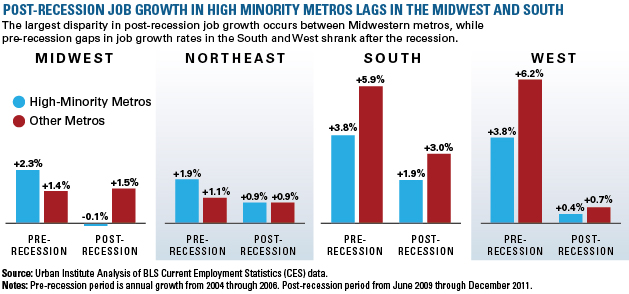
|
|
Minority Communities Job Growth in the Aftermath of the Great Recession: Are Minority Communities Recovering Too?Erica Meade Topic: Employment Data Source:CES The employment numbers from the last couple of months send encouraging signals about the economy's recovery from the Great Recession. Unemployment continues to decrease and the number of jobs added grows steadily. However, the Great Recession disproportionally affected minorities and if the economic recovery does not reach to the areas in which they live, many will face continued joblessness or underemployment. Between June 2009 and December 2011, total nonfarm employment in the United States grew by 1.2 percent. Just over half of the nation's 100 largest metro areas experienced growth equal to or greater than the country as a whole. The levels of growth in high minority metros identified in an earlier commentary are quite similar. Half of these areas added total jobs at rates greater than or equal to the national level of growth. McAllen, TX had the highest share at 7.7 percent and Boston the lowest at 1.4 percent. Although job growth in the high minority metro areas mirrors overall trends for the top 100 metros during the economic recovery, closer examination reveals contrasts between communities with large minority concentrations and those with smaller shares of minority populations, particularly at the regional level. Midwestern metros with substantial minority populations had minimal or negative net job growth compared to region's other metros, with the exception of Detroit and Indianapolis. As a whole, the region's high minority metros had the lowest rate of job growth of all regions from June 2009 through December 2011 (figure 1). In the West, San Jose was the only metro area with a substantial minority population to add jobs at rate higher than that of U.S. as a whole. The region's other high minority metro areas, however, either gained few jobs or lost them. Stockton was among the weakest of the 100 largest metro areas (-1.9 percent). Two-thirds of the South's high minority metros added jobs at rates greater than or equal to the national level, but they still lag behind the region's other metros. Five of these areas are within top 15 in job growth out of 100 the largest metro areas (McAllen, Houston, El Paso, Charleston, and Miami). But, 60 percent of the South's metros with job growth rates below the national average have large minority populations. Even so, looking at job growth over the last year and a half can be somewhat misleading without providing a comparison; since the Great Recession resulted in such great job loss, the only way to go is up. Prior to the beginning of the recession, between 2004 and 2006, many metro areas, including those with substantial minority populations, added jobs at a healthy rate (figure 2). Metros in the South and West regions boasted median job growth rates that far surpassed those in the Midwest and Northeast. The greatest disparity between pre-recession job growth and growth during the recovery period occurs in Western metros which, for the most part, had very strong job growth between 2004 and 2006. These areas have a long way to go before reaching growth anywhere near pre-recession levels, and those with high minority populations are even further behind. Only San Jose added jobs at a faster rate since June of 2009 than it did between 2004 and 2006. Metros in the Midwest had positive, albeit mediocre, median annual job growth between 2004 and 2006, with higher rates of growth in areas with substantial minority populations. Now, only Detroit is outperforming its pre-recession job growth levels, while the region's other high minority metros continue to struggle. Meanwhile, Midwestern metros without substantial minority populations have rebounded to pre-recession job growth levels. The level of variation in economic strength and volatility following the Great Recession suggests that some areas of the country are lagging behind in the recovery. Policymakers should be attentive to the trends observed here, particularly at the regional level. Stark regional differences suggest that the recovery will play out differently for high minority metros in the West and Midwest compared to the regions' metros with smaller minority populations. If these trends persist as the economic climate of the nation improves, failure to address them could mean that minority populations in certain communities run the risk of not benefiting fully from the effects of the economic recovery. |
Experts Feedback
Send us your comments to help further the discussion. Share
Commentaries
|






 Erica E. Meade
Erica E. Meade